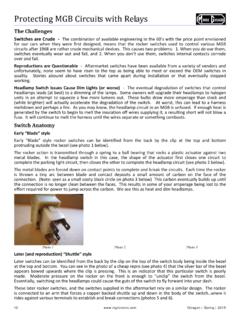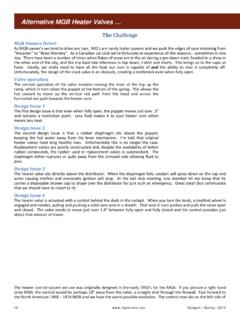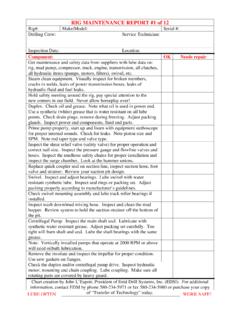Transcription of MGB Brake Calipers - MG Car Club of Toronto | MGCCT
1 MGB Brake Calipers (Reprinted from the Sports Car Chronicle Fall, 2008) MGB Calipers suffer from a couple of common problems. The caliper pistons are chrome plated to prevent rusting. Eventually the chrome peels off the outer surface of the pistons. Rust then develops (since the pistons are steel) where the chrome is gone. Rust on the pistons causes two problems to develop: The rusted, rough, surface causes seal damage as the pistons slide in and out of their caliper bores. This quickly leads to fluid leaks. A soft Brake pedal and loss of braking become obvious. The outer seal on this caliper is ripped. Looking a little further in, you can see large chunks of rust, which have adhered to the caliper bore. It is build-ups like this that cause the pistons to seize. See the vertical scratches on the outside of the piston? Sliding over rust accumulations inside the caliper causes them.
2 In so doing, they tear away at the rubber hydraulic seals until leaks develop. The chrome has failed on a lot of the surface, causing rust as well. The rusted pistons jam in the caliper and won t retract after the Brake pedal is released. This causes the brakes to drag. When this occurs, continuous contact of the Brake pads with the rotors will cause excessive heat to develop, often resulting in warped and damaged rotors. This can often be felt while driving. The Brake pedal will oscillate slightly. In a severe case there will be an unpleasant burning smell. Left long enough, the hub and rotor will heat up so much that the wheel bearing grease will melt and leak out. This may also damage the wheel bearings Brake caliper Rebuilding If your budget allows, you can simply purchase and install rebuilt Calipers on your car. However, rebuilding your own Calipers is not that difficult.
3 Be wary of cheap rebuilt Calipers that may be offered for sale. When you consider that the parts cost about $75 to properly overhaul each caliper , just how good a job can you expect when you purchase supposedly overhauled Calipers for $99 each? At Obsolete we offer rebuilt Calipers at a fair price ($179) but this price includes all the necessary parts being replaced as well as proper cleaning and overhaul. You be the judge! Should you decide to tackle the job yourself, proceed as follows: caliper as removed from the car. Note that it is easiest to leave the pads and retainers in place when removing the caliper from the car. Wouldn t you rather remove these parts with the caliper on your workbench rather than stooping down underneath the front fender! Jack up the car and put it on safety stands. Have an assistant press the Brake pedal very slightly while you watch the operation of one caliper .
4 Both pistons in the caliper should be seen to move in towards the Brake rotor. Do the same test on the other caliper . Should the pistons be free to move on both Calipers , the Calipers can be unbolted and removed. If one or more pistons are seized, they can be freed up as follows: Remove the Brake pad in front of the seized piston. Pushing down hard on the Brake pedal will usually push the seized piston out. Be careful though as the piston will blow out violently when it becomes unstuck. A certain amount of finesse will be needed to do the job without making a big mess. Remove the caliper (s) intact from the car. We DO NOT recommend splitting the caliper in half. Therefore, DO NOT remove the two bolts which secure the two halves of the caliper together. Dump as much Brake fluid out of the caliper as possible. If you are patient, most of it will dribble out of the Brake hose. The pistons will now be removed from the caliper .
5 If you have disconnected the Brake hose and removed the caliper from the car with pistons still installed, proceed as follows: Mount the caliper in a vice. The caliper -mounting flange can be clamped into your bench vice. If you have compressed air available, all the better. After unscrewing the Brake flex hose from the caliper , an air gun nozzle can be pushed into the Brake hose port on the caliper . Put a little air pressure in the hole while watching the pistons. Use goggles or safety glasses while doing this. Brake fluid will spray out when the pistons come out of the caliper body! Put only a little air in at a time while watching the pistons. Should one piston move more than the other, use a C clamp to stop the looser piston from moving. This will force the more stuck piston to move out. The object is to move both pistons as far out of their bores as possible, at the same time. You will reach a point where both pistons are three quarters of the way out of the caliper bores.
6 They will almost be touching each other. Remove the caliper from the vice and hold it over a garbage can or several rags. Using your fingers, grasp and pull one piston until it comes right out. It may be necessary to wiggle and twist it. When it comes out, all the Brake fluid inside the caliper will come streaming out. It makes a big mess, hence the garbage can. The second piston should be similarly removed. Unfortunately we don t live in a perfect world. Often the pistons cannot be removed by hand. Since the pistons are usually rusted and not suitable for reuse, more severe methods can be used if necessary. Should this be the case (and it usually is), clamp the caliper back into the vice. You can use water pump pliers or vice grips to grasp and yank the pistons out. In severe cases you can even resort to a small cold chisel and hammer and rock the pistons out.
7 After the pistons are out, the bleed screw must be removed. This job must be done with great care. The bleed screws are often extremely rusty. Simply trying to unscrew the bleed screw with a wrench may well cause it to break off. This is a most unpleasant experience indeed! We recommend using an air impact gun. Failing that put a tight fitting box wrench (7/16 ) onto the bleed screw and give it a whack with a hammer. This usually works. After loosening, unscrew and remove the bleed screw. Inside the caliper bores, the outer rubber dirt seal with retainer ring, and the inner hydraulic seal will be plainly visible. A stout slot screwdriver can be used to remove the outer seal with its retaining ring. A quick flip of the wrist will usually force these out. The inner seal can be fished out with a very small slot screwdriver. The caliper body should then be inspected. If either caliper bore is seriously rusted or there are any cracks or breaks in the caliper body, discard it.
8 Provided all is well, the caliper should be cleaned and painted. Cleaning Since there are rubber fluid channel seals between the two halves of the caliper , varsol or other petroleum solvents should not be used. Solvents like these may damage the seals causing fluid leaks. Generally, Calipers are quite rusty on the outside. The best cleaning method that we know of is bead blasting. Care should be taken not to blast excessively in the caliper bores. After blasting, the exterior of the caliper should be painted. Following this, the caliper should be scrupulously cleaned. We recommend very hot water & soap for this. Dry the caliper immediately to prevent rusting. Lots of compressed air should be blown through the caliper to remove any blasting media, water, or other foreign matter. Examine the caliper bores. They should be spotlessly clean and smooth. Any rust or debris should be removed. A little sanding can be done if needed.
9 Clean the bores out again after this. Check the threaded holes for the bleed screw and fluid hose. Chase the threads with a tap (3/8 X 24 UNF). Blow out the caliper with air again after this! Using a piece of lint free paper towel, clean out the recesses in the caliper for the hydraulic seal and dirt seals. Assembly Good practice dictates that the seals be replaced. Never reuse them. You will note that the seal kit includes dirt seals and hydraulic seals. They must be installed in the correct location. The hydraulic seal has a square cross section. The outer dirt seal has a somewhat concave cross section. From the looks of this picture, the wrong seal was supplied! Not though. A little persuading with the fingers and the seal will pop right down into position. Smear a little rubberlube on the new hydraulic seal and work it into its recess in the bore. While it may seem to be too big, it will eventually go into place.
10 Be sure that it is not twisted. Do the same for the second hydraulic seal. Pistons should slide in with hand pressure only. If it gets too tight, don t push harder! Pull it out and see what the problem is. Often the piston will simply be cocked in the hole. It is now time to install the pistons. Generally, new pistons will be needed. DO NOT install used pistons unless they are in absolutely perfect condition. Any external rusting dictates that they get thrown out and replaced. A little rusting inside the piston-adjacent to the Brake pad is acceptable. Smear a little rubberlube onto the outside of each piston and push them half way into their bores. The small cut out in the edge of the piston should point down, towards the caliper -mounting flange. Assemble the rubber dust seals into the steel retaining rings. The seals can be worked into the rings with the fingers.










